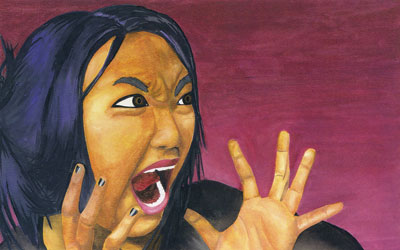All Nonfiction
- Bullying
- Books
- Academic
- Author Interviews
- Celebrity interviews
- College Articles
- College Essays
- Educator of the Year
- Heroes
- Interviews
- Memoir
- Personal Experience
- Sports
- Travel & Culture
All Opinions
- Bullying
- Current Events / Politics
- Discrimination
- Drugs / Alcohol / Smoking
- Entertainment / Celebrities
- Environment
- Love / Relationships
- Movies / Music / TV
- Pop Culture / Trends
- School / College
- Social Issues / Civics
- Spirituality / Religion
- Sports / Hobbies
All Hot Topics
- Bullying
- Community Service
- Environment
- Health
- Letters to the Editor
- Pride & Prejudice
- What Matters
- Back
Summer Guide
- Program Links
- Program Reviews
- Back
College Guide
- College Links
- College Reviews
- College Essays
- College Articles
- Back
Female Anger in Pop Culture
In Shakespeare’s “Hamlet,” Ophelia died silently and apathetically, floating into the still waters of the brook, surrounded by twisting reeds and dancing willow trees. Ophelia – who was ordered and controlled by her father, threatened by her brother, and emotionally abused by her boyfriend, Hamlet – represented the ultimate victim of patriarchal oppression. Her passivity, even in her death, was her defining characteristic. Even the cause of her death is unknown: did she accidentally fall and drown into the water after being weighed down by her heavy dress? Or did she slip into the water voluntarily and, as Queen Gertrude described it, “incapable of her distresses?” Ophelia’s feminine character portrays the image of a forever-saddened girl, just like the thousands of depictions of helpless women in today’s popular culture. Society is further emulating this vision of females by transforming sadness into anger.
The trope of distressed women is found everywhere in our environment. In Greek mythology, Princess Andromeda is punished through sacrifice after her mother boasts of her superior beauty. Fairytale classic Sleeping Beauty is trapped in her own tragic spell, only to be rescued by heroic Prince Charming. Bella Swan, protagonist of “Twilight,” constantly relies on protection and nearly dies when savior, Edward, breaks up with her. We are attracted to these presentations of suffering women because, after all, a damsel in distress depends on her knight in shining armor to rescue her.
Angry women are treated less kindly. A study from Harvard’s Kennedy School of Government revealed that, when showed videos of men and women interviewing for jobs, people were more likely to rate angered women as less competent and deserving of the jobs and readily attributed their irritation to their personality. In an article from The New York Times titled, “I Used to Insist I Didn’t Get Angry. Not Anymore,” essayist Leslie Jamison writes, “[The angry woman] conjures a lineage of threatening archetypes: the harpy and her talons, the witch and her spells, the medusa and her writhing locks.” She is viewed as distastefully rebellious, unnaturally masculinized and threatening to our way of life.
In her recently-released song “Maritimers Apartment Complex” from her soon-to-be-released album, American pop artist Lana Del Rey sings:
“You took my sadness out of context,
At the Mariners Apartment Complex,
I ain’t no candle in the wind,
You lose your way, just take my hand,
You’re lost at sea, then I’ll command your boat to me again.”
These lyrics symbolize a change in the feminist mindset. Del Rey is a musician who has built an entire empire around her sadness and sings lines of bitterness: “And there’s no remedy for memory your face / Is like a melody, it won’t leave my head / Your soul is haunting me and telling me / That everything is fine / But I wish I was dead.” She has simultaneously been called a female icon and an anti-feminist. Now, suddenly, she is diverging from fragility to strength. While her previous albums – “Born to Die” (2012) and “Ultraviolence” (2014) – highlight sadness, her new album promises a greater emphasis on anger. This is reminiscent of Sylvia Plath’s iconic sad poetry, which tiptoed between fabled lines of depression and empowerment.
A staple of feminist literature is exploring contrast between the sorrowful and frustrated female characters. The #MeToo movement is normalizing female retaliation and strength to name abusers and not permitting passivity in the face of harassment as in Ophelia’s fate. In the hearing of Brett Kavanaugh, Christine Blasey Ford was poised as his opposing side of the sad-anger continuum, and the entire scandal was a metaphor of patriarchal oppression. People are drawing attention to the fact that women are twice as likely as men to be diagnosed with unhappy disorders (i.e., depression), while hyperactive disorders (i.e., ADHD) are more often identified in men. Until 1952, female hysteria was a true diagnosis. When the stereotypical miserable woman is widely adopted, it has disastrous and oftentimes completely avoidable consequences.
Society is stuck in an in-between state. The past 50 years have seen revolutionary transformations in our interpretations of gender roles. Today’s feminist movements are traversing from the exhausted archetype of the sad girl to the triumphant vision of the angry woman. This foundation is flawed yet victorious in millions of different ways, and popular culture is undoubtedly starting to mirror the idea that women deserve the right to be angry. They are not sinking helplessly into water; they are championing from the ashes.

Similar Articles
JOIN THE DISCUSSION
This article has 1 comment.
7 articles 7 photos 33 comments
Favorite Quote:
"Stay gold, Ponyboy." -Johnny Cade (S.E. Hinton)<br /> "One moment of pain is worth a lifetime of glory." - Louis Zamperini